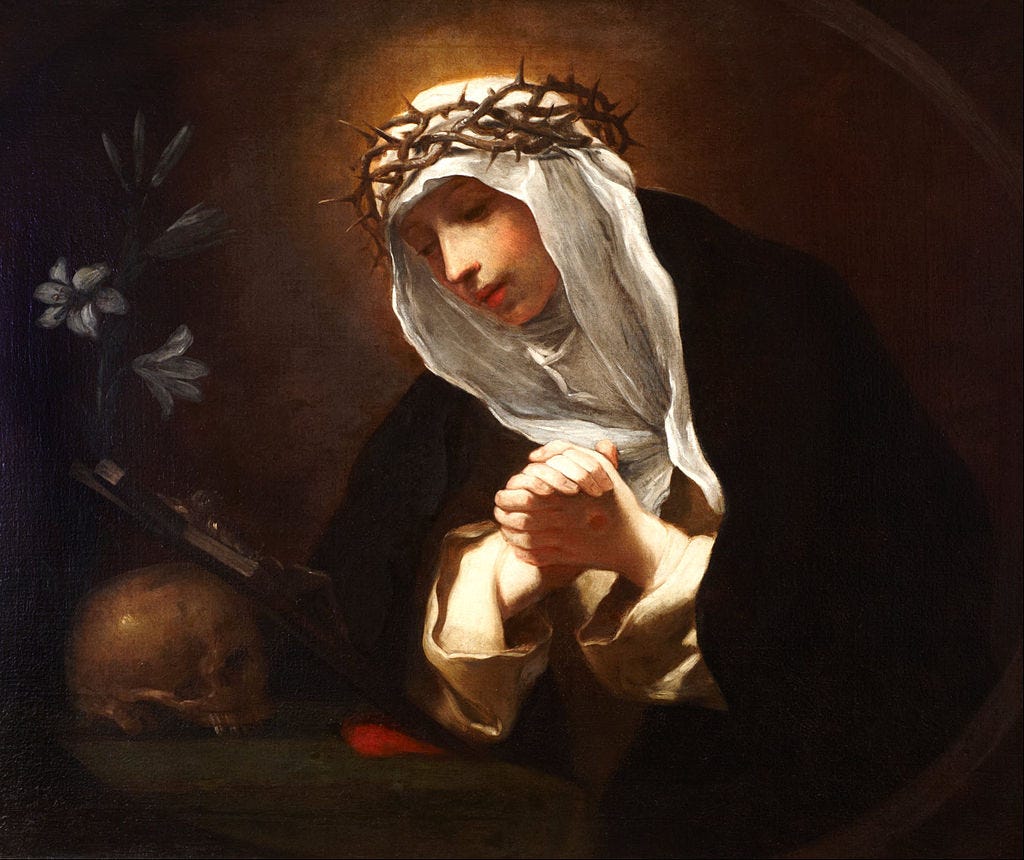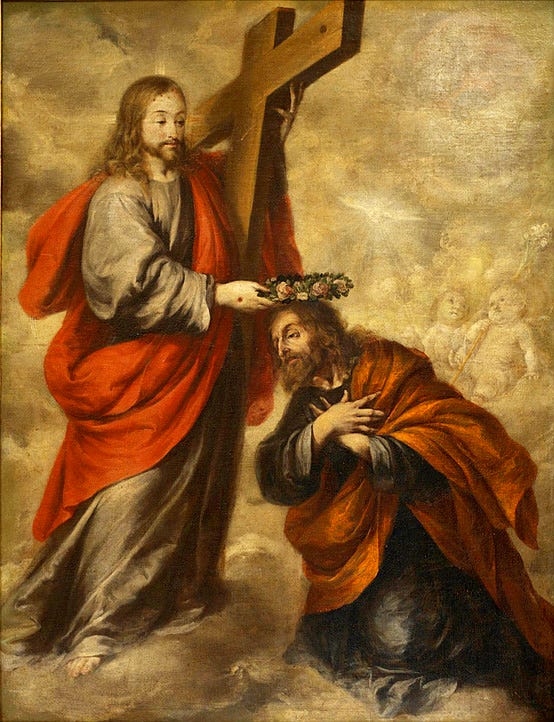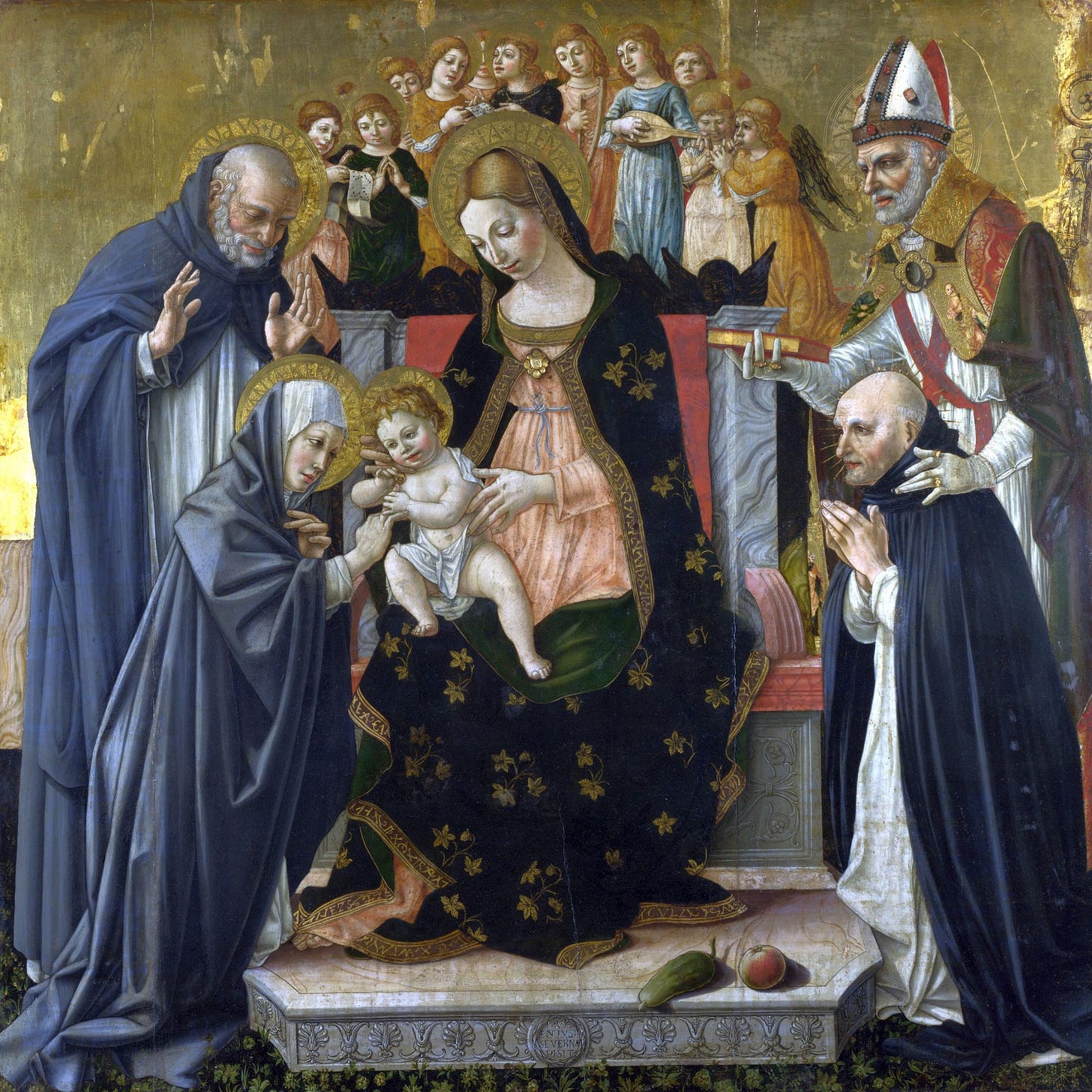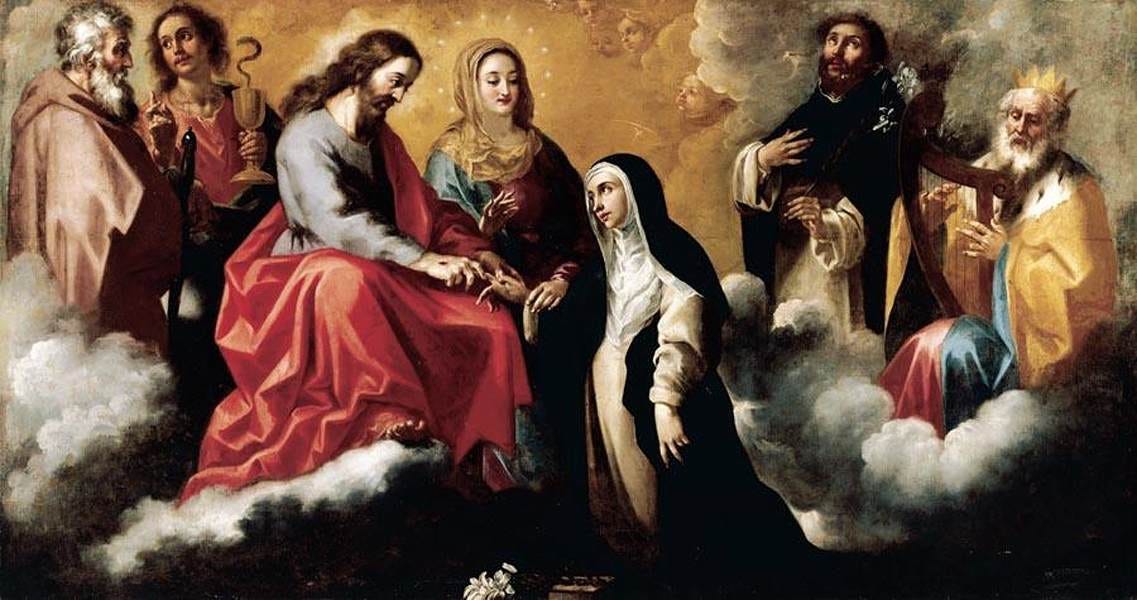Happy Feast of St Catherine of Siena
Final day of Novenas to St Catherine and St Joseph + Walpurgisnacht
With the death of Pope Francis and forthcoming conclave, join us in our final day of praying these two critical Novenas for the intercession of St Catherine of Siena, Co-Patroness of Rome and Europe whose Feast Day is today, and St Joseph, Patron of the Universal Church, in anticipation of his Feast of St Joseph the Worker on May 1st.
Please join us in praying for the following intentions:
The repose of the soul of Jorge Mario Bergoglio
The election of a Holy Pope who neither fears the powerful of this world nor compromises with the spirit of the age
The election of a Holy Pope who preserves, strengthens, and defends the Catholic Faith unto the shedding of their blood
The election of a Holy Pope who observes, protects, and hands on the Traditional Roman Rite of the Holy Catholic Church
Novena to Saint Catherine of Siena
Pray this novena starting on 22 April and ending on 30 April, the eve of the Feast of St. Catherine of Siena on 30 April.
Catherine, fairest and most glorious of the daughters of St. Dominic, by that spirit of prayer, which was your delight from your infancy, obtain for us the love and practice of prayer, and the grace so to converse with God as to become daily more pleasing to Him.
Pray a Gloria
By that especial love which you, O great saint, bore to the virtue of purity, consecrating yourself at eight years of age to the Lord by an irrevocable vow, and afterwards by rejecting the most honorable offers of marriage: obtain for us, we pray you, the grace to be always pure in mind and heart, and to detest and abhor everything which could offend in the smallest degree against a virtue so sublime that it raises men to the rank of angels, and makes them most beloved by God.
Pray a Gloria
By that spirit of retirement which made you, O great saint, desire to behold no one but your Jesus, Who when you were distracted by continual employment in your family, taught you to build a solitude in your heart and keep it at all times filled with thoughts of heaven: obtain for us, we pray, the grace so to love solitude and retirement, however the world may invite us to share its pleasures and its pomps, that our hearts may always turn to God amidst the most dissipating cares which may come upon us in our state of life.
Pray a Gloria
By the spirit of penance which taught you to inflict upon yourself, even in your earliest years, the most painful mortifications: obtain for us the grace to bear with patience whatever afflictions God may be pleased to order for our good, and to mortify voluntarily all the perverse inclinations of our hearts, and all the unruly desires of our senses, that we may become, in some measure, like our crucified model, Jesus.
Pray a Gloria
By that heroic charity which led you, O great saint, to attend and minister with your own hands to the poor sick who had been abandoned by all others in disgust, and for which you were repaid only by insult, rudeness, and persecution: obtain of the Lord for us the grace to be, at all times, equally ready to assist our neighbor in his necessities, and to pardon him generously when he returns only insults for the benefits we confer on him, that we may merit the blessedness promised in this life and the next to meekness and true mercy.
Pray a Gloria
By that supernatural light with which you, O great saint, were miraculously enabled to counsel the Roman Pontiff, who came in person to consult you, when you obtained for him a reconciliation with his adversaries, and his return to Rome: obtain for us of the Lord the grace to know, in all our doubts, that which is most conformable to the will of God, and most conducive to the salvation of souls, that in all our actions we may promote the honor of God and the welfare of our neighbor.
Pray a Gloria
By that especial devotion which you, O great saint, had to Jesus Christ in the Blessed Sacrament, Who sometimes communicated you with His own hands: obtain for us, we pray you, the grace to feel toward the Blessed Sacrament the most fervent devotion, that we may rejoice to converse with Jesus and receive Him into our bosoms to His honor and glory, and for the salvation of our souls.
Pray a Gloria
St. Catherine, pray for us, that we may obtain what we desire through this novena, if what we ask be pleasing to God and conducive to our eternal salvation. May the will of God be done. Amen.1
Unfailing Novena to St. Joseph
This prayer, it is said, has “has never been known to fail, provided that the request is for one’s spiritual benefit or for those whom we are praying for.” Pray it for nine mornings.
O St. Joseph, whose protection is so great, so strong, so prompt before the throne of God, I place in you all my interest and desires.
O St. Joseph, do assist me by your powerful intercession, and obtain for me from your divine Son all spiritual blessings, through Jesus Christ, our Lord. So that, having engaged here below your heavenly power, I may offer my thanksgiving and homage to the most loving of Fathers.
O St. Joseph, I never weary of contemplating you, and Jesus asleep in your arms; I dare not approach while He reposes near your heart. Press Him close in my name and kiss His fine head for me and ask Him to return the kiss when I draw my dying breath. St. Joseph, patron of departing souls, pray for me. Amen.
The Liturgical Year
By Dom Prosper Geuranger
The Dominican Order, which, yesterday, presented a rose to our Risen Jesus, now offers Him a lily of surpassing beauty. Catherine of Sienna follows Peter the Martyr: it is a coincidence willed by Providence, to give fresh beauty to this season of grandest Mysteries. Our Divine King deserves everything we can offer Him; and our hearts are never so eager to give Him every possible tribute of homage, as during these last days of His sojourn among us. See how nature is all flower and fragrance at this loveliest of her seasons! The spiritual world harmonizes with the visible, and now yields her noblest and richest works in honour of her Lord, the Author of Grace.
How grand is the Saint, whose Feast comes gladdening us today! She is one of the most favoured of the holy spouses of the Incarnate Word. She was His, wholly and unreservedly, almost from her very childhood. Though thus consecrated to Him by the vow of holy Virginity, she had a mission given to her by divine Providence which required her living in the world. But God would have her to be one of the glories of the Religious State; He therefore inspired her to join the Third Order of St. Dominic. Accordingly, she wore the Habit and fervently practised, during her whole life, the holy exercises of a Tertiary.
From the very commencement, there was a something heavenly about this admirable servant of God, which we fancy existing in an angel who had been sent from heaven to live in a human body. Her longing after God gave one an idea of the vehemence wherewith the Blessed embrace the Sovereign Good on their first entrance into heaven. In vain did the body threaten to impede the soaring of this earthly Seraph; she subdued it by penance, and made it obedient to the spirit. Her body seemed to be transformed, so as to have no life of its own, but only that of the soul. The Blessed Sacrament was frequently the only food she took for weeks together. So complete was her union with Christ, that she received the impress of the sacred Stigmata, and, with them, the most excruciating pain.
And yet, in the midst of all these supernatural favours, Catherine felt the keenest interest in the necessities of others. Her zeal for their spiritual advantage was intense, whilst her compassion for them, in their corporal sufferings, was that of a most loving mother. God had given her the gift of Miracles, and she was lavish in using it for the benefit of her fellow creatures. Sickness, and death itself, were obedient to her command; and the prodigies witnessed at the beginning of the Church were again wrought by the humble Saint of Sienna.
Her communings with God began when she was quite a child, and her ecstasies were almost without interruption. She frequently saw our Risen Jesus, Who never left her without having honoured her, either with a great consolation, or with a heavy cross. A profound knowledge of the mysteries of our holy faith, was another of the extraordinary graces bestowed upon her. So eminent, indeed, was the heavenly wisdom granted her by God, that she, who had received no education, used to dictate the most sublime writings, wherein she treats of spiritual things with a clearness and eloquence which human genius could never attain to, and with a certain indescribable unction which no reader can resist.
But God would not permit such a treasure as this to lie buried in a little town of Italy. The Saints are the supports of the Church; and though their influence be generally hidden, yet, at times, it is open and visible, and men then learn what the instruments are, which God uses for imparting blessings to a world, that would seem to deserve little else besides chastisement. The great question, at the close of the 14th Century, was the restoring to the Holy City the privilege of its having within its walls the Vicar of Christ, who, for sixty years, had been absent from his See. One saintly soul, by merits and prayers, known to heaven alone, might have brought about this happy event, after which the whole Church was longing; but God would have it done by a visible agency, and in the most public manner. In the name of the widowed Rome, in the name of her own and the Church's Spouse, Catherine crossed the Alps, and sought an interview with the Pontiff, who had not so much as seen Rome. The Prophetess respectfully reminded him of his duty; and in proof of her mission being from God, she tells him of a secret which was known to himself alone. Gregory the Eleventh could no longer resist; and the Eternal City welcomed its Pastor and Father. But at the Pontiff's death, a frightful schism, the forerunner of greater evils to follow, broke out in the Church. Catherine, even to her last hour, was untiring in her endeavours to quell the storm. Having lived the same number of years as our Saviour had done, she breathed forth her most pure soul into the hands of her God, and went to continue, in heaven, her ministry of intercession for the Church she had loved so much on earth, and for souls redeemed in the precious Blood of her Divine Spouse.
Our Risen Jesus, Who took her to her eternal reward during the Season of Easter, granted her whilst she was living on earth, a favour, which we mention here, as being appropriate to the mystery we are now celebrating. He, one day, appeared to her, having with Him His Blessed Mother. Mary Magdalene, she that announced the Resurrection to the Apostles, accompanied the Son and the Mother. Catherine's heart was overpowered with emotion at this visit. After looking, for some time, upon Jesus and His holy Mother, her eyes rested on Magdalene, whose happiness she both saw and envied. Jesus spoke these words to her: "My beloved! I give her to thee, to be thy mother." Address thyself to her, henceforth, with all confidence. I give her special charge of thee." From that day forward, Catherine had the most filial love for Magdalene, and called her by no other name than that of Mother.
Let us now read the beautiful, but too brief, account of our Saint's Life, as given in the Liturgy.
Catharine, a virgin of Sienna, was born of pious parents. She asked for and obtained the Dominican habit, such as it is worn by the Sisters of Penance. Her abstinence was extraordinary, and her manner of living most mortified. She was once known to have fasted, without receiving anything but the Blessed Sacrament, from Ash Wednesday to Ascension Day. She had very frequent contests with the wicked spirits, who attacked her in divers ways. She suffered much from fever, and other bodily ailments.
Her reputation for sanctity was so great, that there were brought to her, from all parts, persons who were sick or tormented by the devil. She, in the name of Christ, healed such as were afflicted with malady or fever, and drove the devils from the bodies of them that were possessed.
Being once at Pisa, on a Sunday, and having received the Bread of heaven, she was rapt in an ecstacy. She saw our crucified Lord approaching to her. He was encircled with a great light, and from His five Wounds there came rays, which fell upon the five corresponding parts of Catherine's body. Being aware of the favour bestowed upon her, she besought our Lord, that the stigmata might not be visible. The rays immediately changed from the colour of blood into one of gold, and passed, under the form of a bright light, to the hands, feet, and heart of the Saint. So violent was the pain left by the wounds, that it seemed to her as though she must soon have died, had not God diminished it. Thus our most loving Lord added favour to favour, by permitting her to feel the smart of the wounds, and yet removing their appearance. The servant of God related what had happened to her to Raymund, her Confessor. Hence, when the devotion of the Faithful gave a representation of this miracle, they painted, on the pictures of St. Catherine, bright rays coming from the five stigmata she received.
Her learning was not acquired, but infused. Theologians proposed to her the most difficult questions of divinity, and received satisfactory answers. No one ever approached her, who did not go away a better man. She reconciled many that were at deadly enmity with one another. She visited Pope Gregory the Eleventh, (who was then at Avignon,) in order to bring about the reconciliation of the Florentines, who were under an interdict on account of their having formed a league against the Holy See. She told the Pontiff that there had been revealed to her the vow which he, Gregory, had made of going to Rome. a vow which was known to God alone. It was through her entreaty, that the Pope began to plan measures for taking possession of his See of Rome, which he did soon after. Such was the esteem in which she was held by Gregory, and by Urban the Sixth, his successor, that she was sent by them on several embassies. At length, after a life spent in the exercise of the sublimest virtues, and after gaining great reputation on account of her prophecies and many miracles, she passed hence to her divine Spouse, when she was about the age of three and thirty. She was canonized by Pius the Second.
The people of Siena eat a cookie called Ricciarelli on this day. A recipe for you to try:
Ricciarelli
4 egg whites
1 tsp lemon juice
4 1/2 cups almond flour
3 1/2 cups powdered sugar
1/4 tsp pinch salt
1/2 tsp baking powder
2 tsp orange zest
1 1/2 TBSP almond extract
2 tsp vanilla extract
powdered sugar for rolling
Whip together the egg whites and lemon juice until stiff peaks form.
Sift together the almond flour, powdered sugar, salt, and baking powder and fold into the egg whites a third at a time. Add the orange zest, vanilla extract, and almond extract and fold in until mixed.
Line a baking sheet with parchment paper. Grab clumps of the dough and roll into walnut-sized balls. Roll the balls in the powdered sugar, then shape into slight ovals and place on the baking sheet.
Let them sit at room temperature for about an hour, until the tops have dried out. Once the tops are dry, gently squeeze the cookies so little cracks form on the tops. Bake at 300F for about 20 minutes. (This recipe makes about 40 cookies)
Serve your ricciarelli with coffee, tea, or the spiced liqueur now named for our Saint -- L’Elisire di Santa Caterina da Siena (the Elixir of St. Catherine of Siena). It's made from a recipe brought back by friars from the Holy Land and given to the Basilica of San Domenico in Siena. Legend relates that St. Catherine gave some of it to one of the sick people she tended to, thereby effecting a cure.2
Walpurgisnacht
In the Roman martyrology, St. Walburga's Feast -- a day that commemorates the date of her canonization -- is on May 1, though it isn't celebrated liturgically on the 1962 calendar. Her Feast is, however, a great holiday in many European countries, especially in Germany, Finland, Sweden, and Eastern European countries, and the celebrations begin on its eve -- the night of 30 April -- a time known as Walpurgisnacht. Who was St. Walburga, and why is she held is such esteem especially in those areas of the world?
First things first: in the late 7th century, the European continent was still largely pagan territory. Against this backdrop, some monks visited with a noble man at him home in England and told him about their mission work in those wild lands. The man's son, Winfrid, sat listening as the monks recounted their tales, and was so impressed by them that he resolved to follow in their footsteps.
The boy received a religious education, and later joined the Benedictine Order, becoming a priest at age thirty. In A.D. 719, he received permission from Pope Gregory II to evangelize Germany. After difficulties due to political skirmishes, he eventually set up a monastery in Amöneburg and was consecrated Bishop, taking the name "Boniface." His work was most fruitful, and his great success is perfectly symbolized by his destruction of a pagan object of veneration: in Geismar, he took an ax and felled an oak tree dedicated to Thor and considered sacred by the pagans, who were certain that a great lightning strike would kill them all when the tree was toppled. When nothing happened, the man who was to become known as St. Boniface preached the Gospel, converted the people, and built a church out of the tree's wood.3
The typical way of celebrating Walpurgisnacht is to have picnics, and bonfires to recall the divine light that illuminated Walburga's convent. As we watch the flames, we can pray the Litany to St. Walburga. It's traditional, too, to gather greenery and oak branches at dusk, adorn them with symbols of Christ, Walburga, and the Benedictine Order, and use them to decorate our homes (the English of Lincolnshire would hang cowslip flowers -- Primula veris --- to ward off evil). The use of oak branches is a way to recall the Benedectines' victory over paganism, as perfectly seen in the story of St. Boniface and the "sacred oak" recounted above.
And like Hallowe'en, the veil between this world and the afterworld is said to become thin tonight, the damned dead are believed to become restless, and devils are said to cause trouble. Prayers against them and for pagans and witches who hold their sabbats and toy with demons tonight would be a wonderful thing. May St. Walburga, who -- with St. Boniface, her brothers, and other Benedictines -- brought the good news of Christ to Germany, intercede for them now and bring them to Christ.
The Czech people have a second way to deal with witches: they make little straw dolls to represent them, and toss the dolls into their bonfires' flames. They follow up by dining on roasted sausages and beer.
The spooky nature of Walpurgisnacht because of witches' doings is recalled in Goethe's Faust, and in his poem The First Walpurgis Night (Die Erste Walpurgisnacht) which was set to music by Felix Mendelssohn:
This focus on the fight against evil is a perfect beginning to the celebrations of tomorrow -- May 1 -- when we crown Our Lady as the Queen of May. Because of the proximity of Walpurgisnacht to May Day, time around the bonfires tonight could be spent weaving garlands of flowers with which to crown Our Lady tomorrow -- a day on which the people of Finland eat funnel cakes:
Tippaleipä (Finnish May Day funnel cakes)
2 cup all-purpose flour
4 tablespoons sugar
1 teaspoon baking powder
1/2 teaspoon fine salt
1 cup milk
4 eggs
2 teaspoons vanilla
oil for deep frying
Powdered sugar for serving
Whisk flour, salt, baking powder and sugar together. Set aside.
Whisk milk, eggs and vanilla together in a big bowl. Add the dry ingredients and whisk until completely smooth.
Pour the oil into a deep pot and heat over medium heat until the temperature reaches 350 degrees. When the oil is hot, transfer the batter into a funnel (or, if you don't have one, put it into a ziploc bag, and cut a tiny hole in the corner of the bag).
Drizzle the batter into the hot oil in jaggedy motions --- make figure eights, zig-zags, etc. -- such that you end up with a messy circle of overlapping strings of dough about 4 inches in diameter. Fry until golden brown, about 45 seconds to 1 minute on each side. Drain on paper towels, dust with powdered sugar, and serve immediately (in Lithuania, funnel cakes are served with honey).
In Germany, many make a pilgrimage to her monastery on St. Walburga's feast itself.
Finally, please save the aforementioned date for our Annual Celebration of the Feast of St Joseph the Worker on Thursday, May 1st at Epiphany of Our Lord Church in Tampa, FL! This is a tremendous opportunity to celebrate the Easter season and the Patron of Fathers, Families, Workers, and the Universal Church.
Our presenting speaker is Joshua Charles of Eternal Christendom!
https://fisheaters.com/novenas.html#siena
https://fisheaters.com/stcatherineofsiena.html
https://fisheaters.com/walpurgisnacht.html#1










